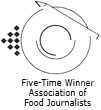Introduction
Why do certain spices and dishes show up far from their origins, and how can tracing these cultural “foodways” change the way we think about wine and food pairing? Why did Cha create her own flavour wheel rather than rely on traditional wine-tasting vocabulary? How can expanding your flavour vocabulary through travel, food, and culture help us describe wine in ways that feel relatable?
In this episode of the Unreserved Wine Talk podcast, I’m chatting with Cha McCoy, author of the new book Wine Pairing for the People.
You can find the wines we discussed here.
Giveaway
Three of you are going to win a copy of Cha McCoy’s terrific new book, Wine Pairing for the People: The Communion of Wine, Food, and Culture from Africa and Beyond
How to Win
To qualify, all you have to do is email me at [email protected] and let me know that you’ve posted a review of the podcast.
It takes less than 30 seconds: On your phone, scroll to the bottom here, where the reviews are, and click on “Tap to Rate.”
After that, scroll down a tiny bit more and click on “Write a Review.” That’s it!
I’ll choose three people randomly from those who contact me.
Good luck!
Join me on Instagram, Facebook and YouTube Live Video
Join the live-stream video of this conversation on Wednesday at 7 pm eastern on Instagram Live Video, Facebook Live Video or YouTube Live Video.
I’ll be jumping into the comments as we watch it together so that I can answer your questions in real-time.
I want to hear from you! What’s your opinion of what we’re discussing? What takeaways or tips do you love most from this chat? What questions do you have that we didn’t answer?
Want to know when we go live?
Add this to your calendar:
Highlights
- Which one of Cha’s wine and food pairings might receive the most pushback from traditionalists?
- What does cultural terroir mean?
- How do cultural factors influence a country’s wine preferences and the wine styles it produces?
- Why does Brazil’s vibrant culture make sparkling wine such a natural fit?
- What are foodways, and how does the journey of ingredients and dishes inform the cultural connections between food and wine pairings across continents?
- How did Cha navigate pairing wines for Senegalese dishes when her formal training had not prepared her for those flavours?
- Why does Cha recommend rich, aromatic white wines for onion and garlic-heavy dishes?
- How did tasting local drinks expand Cha’s wine vocabulary and approach to wine education for diverse audiences?
- Why did Cha create her own flavour wheel that included references and descriptors that differ from traditional industry flavour wheels?
- How can building a personal flavour wheel help drinkers trust their own palates and avoid feeling intimidated by industry jargon?
- What change would Cha make to wine education to make it more globally inclusive?
Key Takeaways
- Why do certain spices and dishes show up far from their origins, and how can tracing these cultural “foodways” change the way we think about wine and food pairing?
- If Peri Peri as a seasoning, as a spice, is being used to make certain dishes, then it makes sense that when immigrants come to live in Portugal, they’re bringing that with them. So you’ll see Peri Peri often, and you’re nowhere near South Africa. it’s on a lot of dishes, and that has a lot to say, about foodways. It is culturally connecting how Peri Peri made its way to Portugal. That’s the foodway of that spice, etc. That act of tracing it back is the foodways. I talk about rum, How do we track back, where some of these origins are. we’re going to call it wineways.
- Why did Cha create her own flavour wheel rather than rely on traditional wine-tasting vocabulary?
- The flavour wheel is commonly used in beginner wine classes to help folks navigate deductive tasting. let’s look at some of my common tasting notes that I’ve used. So I backtrack through my old wine journals and seeing which ones I use often. why would I start throwing in things that I don’t use and smell often? Let’s say saffron, turmeric, these are spices that are in my spice cabinet because I cook with them. I find them in wine, even though WSET vocabulary don’t use them. You can build your own flavour wheel. What are some juices, spices that you’re familiar with, that you can be able to put in?
- How can expanding your flavour vocabulary through travel, food, and culture help us describe wine in ways that feel relatable?
- Turkey, Morocco, made me understand their drinking culture. I feel like it at least helped me even with developing the flavour wheel, or when I’m describing wines for guests. Knowing what that background is, it helped me to be able to explain wines that were… I can translate this wine, knowing that fact about them, or in a restaurant that I know, or a chef making a dish that’s related to this. I wanted to stay away from using vocabularies that is not, you know, if I’m talking to my demographic, I know where they’re from, and I know what they’re drinking, or I know what they’re eating. And so when you are traveling, immersed in fruits and juices, different ways that you can have that. And now it adds to your own lexicon.
Start The Conversation: Click Below to Share These Wine Tips
About Cha McCoy
Cha McCoy, MBA, is an entrepreneur, educator, event producer, and author. As a certified sommelier with the Court of Master Sommeliers, she developed The Communion, a wine dinner series that offers an inviting, accessible approach to gathering and enjoying wine. This experience inspired her to open her first retail space, The Communion Wine & Spirits. The dinner series was profiled in Food & Wine, and Cha was named one of Wine Enthusiast’s 40 Under 40. Her work continues through her highly anticipated book, Wine Pairing for the People: The Communion of Wine, Food, and Culture from Africa and Beyond, available now for pre-order and scheduled for release in November. Cha has held coveted positions such as Cherry Bombe Magazine’s first beverage director, the head of beverage for the Charleston Wine + Food Festival, and a sommelier at a Michelin-starred restaurant in Portugal and John Fraser Restaurant in New York.
Passionate about education, she spends her spare time mentoring and teaching at her alma mater, Syracuse University, where she served as an adjunct professor, educating and inspiring new wine drinkers. Catch Cha if you can in Harlem, New York, or on one of her international adventures.
Resources
- Connect with Cha McCoy
- Natalie’s Appearance on CHCH Morning Live | 4 Wine Gifts That Say “I Have Great Taste” (Without Breaking the Bank)
- Animus Douro Red – Douro Valley, Portugal
- Trivento Malbec Reserve – Mendoza, Argentina
- Pelee Island Advent Calendar – Ontario, Canada
- Lisbon by Night Red Blend – Lisboa, Portugal
- Unreserved Wine Talk
- My Books:
- Wine Witch on Fire: Rising from the Ashes of Divorce,Defamation, and Drinking Too Much
- Audiobook:
- Audible/Amazon in the following countries: Canada, US, UK, Australia (includes New Zealand), France (includes Belgium and Switzerland), Germany (includes Austria), Japan, and Brazil.
- Kobo (includes Chapters/Indigo), AudioBooks, Spotify, Google Play, Libro.fm, and other retailers here.
- Wine Witch on Fire Free Companion Guide for Book Clubs
- Audiobook:
- Unquenchable: A Tipsy Quest for the World’s Best Bargain Wines
- Red, White, and Drunk All Over: A Wine-Soaked Journey from Grape to Glass
- Wine Witch on Fire: Rising from the Ashes of Divorce,Defamation, and Drinking Too Much
- My new class, The 5 Wine & Food Pairing Mistakes That Can Ruin Your Dinner And How To Fix Them Forever
Tag Me on Social
Tag me on social media if you enjoyed the episode:
- @nataliemaclean and @natdecants on Facebook
- @nataliemaclean on Twitter
- @nataliemacleanwine on Instagram
- @nataliemaclean on LinkedIn
- Email Me at [email protected]
Thirsty for more?
- Sign up for my free online wine video class where I’ll walk you through The 5 Wine & Food Pairing Mistakes That Can Ruin Your Dinner (and how to fix them forever!)
- You’ll find my books here, including Unquenchable: A Tipsy Quest for the World’s Best Bargain Wines and Red, White and Drunk All Over: A Wine-Soaked Journey from Grape to Glass.
- The new audio edition of Red, White and Drunk All Over: A Wine-Soaked Journey from Grape to Glass is now available on Amazon.ca, Amazon.com and other country-specific Amazon sites; iTunes.ca, iTunes.com and other country-specific iTunes sites; Audible.ca and Audible.com.

















